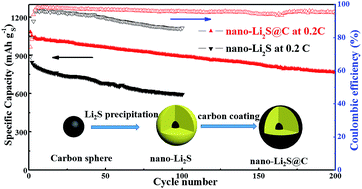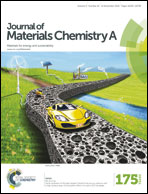Facile and scalable synthesis of nanosized core–shell Li2S@C composite for high-performance lithium–sulfur batteries
Abstract
Lithium sulfide (Li2S) is one of the most promising cathode materials for the next-generation advanced Li-ion batteries because of its high theoretical capacity (1167 mA h g−1) and large energy density. However, Li2S suffers from poor rate performance and short cycle life due to its insulating nature and polysulfide shuttle during cycling. In this work, we have proposed a facile and scalable strategy for the synthesis of nanosized Li2S particles via a solution-based method. For further application in Li–S batteries, chemical vapor deposition (CVD) technology is used to successfully deposit a uniform conductive carbon layer on the Li2S particles to obtain a core–shell structured nanocomposite (nano-Li2S@C). The average size of the as-prepared nano-Li2S particles is around 100 nm, and covered by a carbon shell with a thickness of ∼20 nm. These nanoscale Li2S@C particles guarantee a short diffusion distance of lithium ions and the protective carbon layer allows fast electron transport as well as effectively constraining the migration of the soluble polysulfides. As a result, the core–shell structured nano-Li2S@C cathodes show outstanding electrochemical performance with a high initial discharge capacity of 1083.5 mA h g−1 at 0.2C and 766.3 mA h g−1 after 200 cycles with a low decay of 0.15% per cycle. The enhanced electrochemical performance is due to the core-shelled architecture with enhanced electrical conductivity and better suppression effect for the polysulfide shuttle.


 Please wait while we load your content...
Please wait while we load your content...